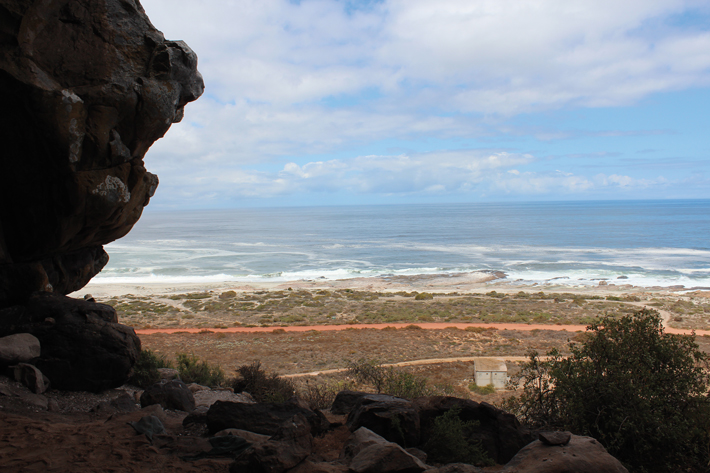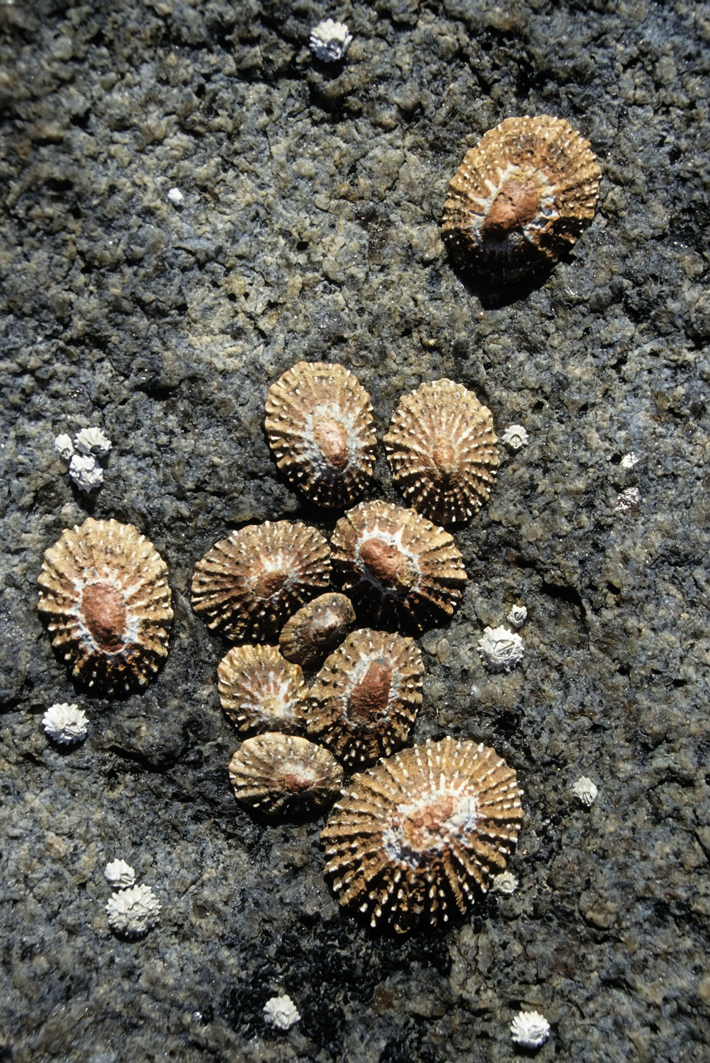Our Coastal Origins
November/December 2020
 As much as 100,000 years ago, modern humans in southern Africa began to settle down. Just how and why this momentous shift in our distant ancestors’ way of life occurred is difficult for scholars to say. Prehistoric hunter-gatherers from this era are among the most challenging humans to study. They did not leave behind any permanent structures as evidence of their presence, and their stone tools are rarely found along with contextual information such as the remains of plants or bones. Other artifacts, including beads or ochre paint, are very rare, and materials such as leather and wood do not survive. But one available resource is evidence of the food they ate. Changes in their diet may have had profound consequences in the transition from living in highly mobile bands of hunter-gatherers to more sedentary communities.
As much as 100,000 years ago, modern humans in southern Africa began to settle down. Just how and why this momentous shift in our distant ancestors’ way of life occurred is difficult for scholars to say. Prehistoric hunter-gatherers from this era are among the most challenging humans to study. They did not leave behind any permanent structures as evidence of their presence, and their stone tools are rarely found along with contextual information such as the remains of plants or bones. Other artifacts, including beads or ochre paint, are very rare, and materials such as leather and wood do not survive. But one available resource is evidence of the food they ate. Changes in their diet may have had profound consequences in the transition from living in highly mobile bands of hunter-gatherers to more sedentary communities.
Among the numerous locations and environments in Africa where archaeologists are currently studying hunter-gatherers, coastal South Africa has some of the earliest evidence of organized social behaviors. At many sites there, the remains of ancient meals, and especially of marine mollusks and shellfish, are abundant. Archaeologist Emma Loftus of the University of Cambridge is using isotope analysis to analyze prehistoric shell deposits—the remains of shellfish harvested by ancient humans—that have been discovered in South African rock shelters. Loftus explains that seashells are particularly informative because they grow in regular seasonal and annual increments, like trees, and survive well in the archaeological record. By measuring a shell’s oxygen isotope ratios, researchers can obtain a record of every growth period in its history, as well as rainfall levels and air and sea-surface temperatures. As long as there is no recrystallization or dissolution where the carbonate structure of the shell partially dissolves, causing irreversibe damage, Loftus thinks that researchers could probably recover this information dating back as much as millions of years ago. Studying a shell’s growth periods also allows archaeologists to determine the season in which it was harvested. “We can track where humans were on the landscape at different times throughout the year,” Loftus says, “and this can shed light on the degree of group mobility, an important component of how ancient societies organized themselves.”
 Archaeologist Curtis Marean of the Institute of Human Origins at Arizona State University believes that placing the role of coastal living in the big picture of human evolution and identifying the shift to “dense and predictable” food resources such as shellfish are crucial to understanding early modern humans’ social evolution. Marean also studies sites on the coast of South Africa and has found that their bountiful food resources encouraged territoriality and that social organization was needed to defend the newly established territory. This, he says, led to intergroup conflict and, in turn, to the development of technology such as projectile weapons. The high nutritional value of shellfish may also have helped boost Homo sapiens’ cognitive capacity. “When hunter-gatherers expanded their diet to include coastal resources, they ended up having characteristics unique among hunter-gatherers,” says Marean. “They didn’t move around the landscape much, and their population increased, as did the complexity of their tool kit.” Such social development is not known to have happened this early anywhere else.
Archaeologist Curtis Marean of the Institute of Human Origins at Arizona State University believes that placing the role of coastal living in the big picture of human evolution and identifying the shift to “dense and predictable” food resources such as shellfish are crucial to understanding early modern humans’ social evolution. Marean also studies sites on the coast of South Africa and has found that their bountiful food resources encouraged territoriality and that social organization was needed to defend the newly established territory. This, he says, led to intergroup conflict and, in turn, to the development of technology such as projectile weapons. The high nutritional value of shellfish may also have helped boost Homo sapiens’ cognitive capacity. “When hunter-gatherers expanded their diet to include coastal resources, they ended up having characteristics unique among hunter-gatherers,” says Marean. “They didn’t move around the landscape much, and their population increased, as did the complexity of their tool kit.” Such social development is not known to have happened this early anywhere else.
Marean further hypothesizes that this sort of social development led to Homo sapiens’ perhaps most significant, and most unusual, quality—cooperation. “Cooperation is an extremely bizarre trait,” says Marean. “The high levels of cooperation with non-kin that modern humans express is completely unique in the animal kingdom.” Eventually, cooperation fostered group migration and led to Homo sapiens’ domination of the planet. It also may have saved the species from extinction. Marean and others working on the South African coast have identified shards of volcanic glass from the cataclysmic eruption of Mt. Toba on Sumatra 74,000 years ago, which some scholars think may have come close to wiping out humanity. Marean believes that shared coastal food resources in South Africa helped several hundred Homo sapiens escape annihilation, and that these fortunate survivors may have become the common ancestors of today’s 7.8 billion modern humans.
Advertisement
IN THIS ISSUE
Digs & Discoveries
Our Coastal Origins
Off the Grid
A Day by the Rhone
Painful Past
Miniature Masterpieces
Precision Instruments
Ship of Plenty
A Tale of Two Pipes
To Reach the Gods
Bronze Age Keepsakes
Honoring the Dead
Paleolithic Bedtime
Laurens' Last Stand
Piggy Playthings
What's in a Norse Name?
Around the World
Poison projectiles, Cortés’ Mexico City abode, Peruvian pelican fertilizer, and solving a Crusader mystery
Artifact
Turning over an old leaf
Advertisement

Recent Issues
-
 May/June 2024
May/June 2024
-
 March/April 2024
March/April 2024
-
 January/February 2024
January/February 2024
-
 November/December 2023
November/December 2023
-
 September/October 2023
September/October 2023
-
 July/August 2023
July/August 2023
-
 May/June 2023
May/June 2023
-
 March/April 2023
March/April 2023
-
 January/February 2023
January/February 2023
-
 November/December 2022
November/December 2022
-
 September/October 2022
September/October 2022
-
 July/August 2022
July/August 2022
-
 May/June 2022
May/June 2022
-
 March/April 2022
March/April 2022
-
 January/February 2022
January/February 2022
-
 November/December 2021
November/December 2021
-
 September/October 2021
September/October 2021
-
 July/August 2021
July/August 2021
-
 May/June 2021
May/June 2021
-
 March/April 2021
March/April 2021
-
 January/February 2021
January/February 2021
-
 November/December 2020
November/December 2020
-
 September/October 2020
September/October 2020
-
 July/August 2020
July/August 2020
-
 May/June 2020
May/June 2020
-
 March/April 2020
March/April 2020
-
 January/February 2020
January/February 2020
-
 November/December 2019
November/December 2019
-
 September/October 2019
September/October 2019
-
 July/August 2019
July/August 2019
-
 May/June 2019
May/June 2019
-
 March/April 2019
March/April 2019
-
 January/February 2019
January/February 2019
-
 November/December 2018
November/December 2018
-
 September/October 2018
September/October 2018
-
 July/August 2018
July/August 2018
-
 May/June 2018
May/June 2018
-
 March/April 2018
March/April 2018
-
 January/February 2018
January/February 2018
-
 November/December 2017
November/December 2017
-
 September/October 2017
September/October 2017
-
 July/August 2017
July/August 2017
-
 May/June 2017
May/June 2017
-
 March/April 2017
March/April 2017
-
 January/February 2017
January/February 2017
-
 November/December 2016
November/December 2016
-
 September/October 2016
September/October 2016
-
 July/August 2016
July/August 2016
-
 May/June 2016
May/June 2016
-
 March/April 2016
March/April 2016
-
 January/February 2016
January/February 2016
-
 November/December 2015
November/December 2015
-
 September/October 2015
September/October 2015
-
 July/August 2015
July/August 2015
-
 May/June 2015
May/June 2015
-
 March/April 2015
March/April 2015
-
 January/February 2015
January/February 2015
-
 November/December 2014
November/December 2014
-
 September/October 2014
September/October 2014
-
 July/August 2014
July/August 2014
-
 May/June 2014
May/June 2014
-
 March/April 2014
March/April 2014
-
 January/February 2014
January/February 2014
-
 November/December 2013
November/December 2013
-
 September/October 2013
September/October 2013
-
 July/August 2013
July/August 2013
-
 May/June 2013
May/June 2013
-
 March/April 2013
March/April 2013
-
 January/February 2013
January/February 2013
-
 November/December 2012
November/December 2012
-
 September/October 2012
September/October 2012
-
 July/August 2012
July/August 2012
-
 May/June 2012
May/June 2012
-
 March/April 2012
March/April 2012
-
 January/February 2012
January/February 2012
-
 November/December 2011
November/December 2011
-
 September/October 2011
September/October 2011
-
 July/August 2011
July/August 2011
-
 May/June 2011
May/June 2011
-
 March/April 2011
March/April 2011
-
 January/February 2011
January/February 2011
Advertisement





